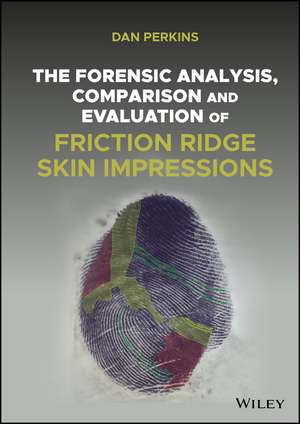The Forensic Analysis, Comparison and Evaluation of Friction Ridge Skin Impressions
Autor DG Perkinsen Limba Engleză Hardback – 24 aug 2022
When friction ridge skin (the skin on the undersides of the hands and feet) contacts a surface an impression of it may be left behind. Impressions that are left inadvertently, for example at a scene where a crime is alleged to have been committed are known as 'marks'. Impressions taken intentionally from a person, for example as a result of their arrest are known as 'prints'.
The Forensic Analysis, Comparison and Evaluation of Friction Ridge Skin Impressions offers step-by-step instruction to examiners tasked with identifying people by the marks they leave behind. Assuming no previous knowledge of the subject, this easy-to-use guide breaks down the ACE (Analysis, Comparison and Evaluation) framework into 10 key questions that provide clear guidance on: establishing the most evidentially valuable mark; the type of details the mark may reveal; the effects of distortion; how to determine which area of skin is most likely to have made the mark, and more. Author Dan Perkins draws upon his years of experience to equip fingerprint examiners with the key skills needed to carry out the appropriate analysis, comparison and evaluation of friction ridge skin impressions.
- Presents a stepwise approach designed for both novice and more experienced fingerprint examiners
- Discusses all aspects of ACE, including the formation of fingerprints, documentation, suitability, and orientation
- Contains references to relevant research, real-world case studies, and hundreds of fingerprints the reader can analyse and compare
- Includes five detailed appendices covering fabrication, transplantation and forgery, verification, bias, activity level propositions, and errors
The Forensic Analysis, Comparison and Evaluation of Friction Ridge Skin Impressions is an indispensable ACE 'checklist' for trainees in the field of fingerprint comparison and identification, qualified fingerprint examiners and forensic science students.
Preț: 529.69 lei
Preț vechi: 761.33 lei
-30% Nou
101.37€ • 104.72$ • 84.36£
Carte indisponibilă temporar
Specificații
ISBN-10: 1119230896
Pagini: 320
Dimensiuni: 179 x 264 x 21 mm
Greutate: 0.83 kg
Editura: Wiley
Locul publicării:Chichester, United Kingdom
Descriere
An accessible, highly practical introduction to the ACE framework Fingerprint Examiners use to analyse, compare and evaluate friction ridge skin impressions.
When friction ridge skin (the skin on the undersides of the hands and feet) contacts a surface an impression of it may be left behind. Impressions that are left inadvertently, for example at a scene where a crime is alleged to have been committed are known as 'marks'. Impressions taken intentionally from a person, for example as a result of their arrest are known as 'prints'.
The Forensic Analysis, Comparison and Evaluation of Friction Ridge Skin Impressions offers step-by-step instruction to examiners tasked with identifying people by the marks they leave behind. Assuming no previous knowledge of the subject, this easy-to-use guide breaks down the ACE (Analysis, Comparison and Evaluation) framework into 10 key questions that provide clear guidance on: establishing the most evidentially valuable mark; the type of details the mark may reveal; the effects of distortion; how to determine which area of skin is most likely to have made the mark, and more. Author Dan Perkins draws upon his years of experience to equip fingerprint examiners with the key skills needed to carry out the appropriate analysis, comparison and evaluation of friction ridge skin impressions.
- Presents a stepwise approach designed for both novice and more experienced fingerprint examiners
- Discusses all aspects of ACE, including the formation of fingerprints, documentation, suitability, and orientation
- Contains references to relevant research, real-world case studies, and hundreds of fingerprints the reader can analyse and compare
- Includes five detailed appendices covering fabrication, transplantation and forgery, verification, bias, activity level propositions, and errors
The Forensic Analysis, Comparison and Evaluation of Friction Ridge Skin Impressions is an indispensable ACE 'checklist' for trainees in the field of fingerprint comparison and identification, qualified fingerprint examiners and forensic science students.
